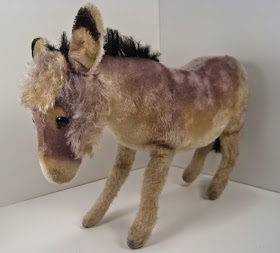It's a rather gray day around these parts, and the almost four feet (that's over 120 cm for friends abroad!) of snow on the ground already is not helping things. But this little grayish friend is just the opposite of gloomy - so Steiffgal thought it would be the perfect time to introduce you to this happy-go-lucky fellow. Take a look at this fantastic vintage farm friend who just arrived on the east coast from Germany. Although not technically "young" anymore - he is certainly young at heart... and will warm yours, too!
Here we have a most adorable and vintage looking donkey. This farm friend measures 22 cm tall (top of head to foot) and 30 cm long (tip of nose to backside.) He is standing, unjointed, and made of tan mohair which has been lovingly airbrushed with grayish-purple highlights. His tail and mane are made from long, soft, black mohair. His face comes to life with longer tan mohair on his "sideburns" and forehead, a shorter mohair muzzle, pert black eyes, and a black airbrushed nose and mouth. The coloring on his face truly gives him him a youthful, playful appearance. He retains his long trailing "F" button and illegible yellow ear tag (pictured below) as his Steiff IDs.
Like many things Steiff, this donkey has details that make him
hard to date and identify with 110% accuracy. His long trailing "F"
button initially suggests that he may have been manufactured in the c. 1933 - 1935
time period. If that were the case, he most resembles the company's Jung Esel or Young Donkey, which was made in 22 and 28 cm from 1933 through 1943 overall. Young Donkey is pictured here on the left; the photo is from Pfeiffer's 1892-1943 Sortiment book. Like the example under discussion today, Steiff's Young Donkey pattern is famous for his grey-purple highlights and innocent looks. However, it is clear that there are some key differences between the Young Donkey pattern and the donkey under discussion here. Young Donkey is made from long grey wool plush; this example is made from highlighted mohair. Young Donkey has grey felt (or
perhaps leather) hooves; this example does not. Young Donkey has a grey tail and mane; this example has black detailing. And Young Donkey has his ears positioned forward; this example has the
ears positioned to the rear.
So how do his design elements and early IDs all align? Well, only this donkey knows for sure, but
here are two ideas.
1. The mid 1930's through the early 1950's were a
really rough time for manufacturing at Steiff, and supplies and fabrics
were available on an inconsistent basis. It is possible that
this donkey was indeed made to the Jung Esel pattern as best as possible, but with the materials and technology available on hand, in the late 1930's to early 1940's. It is not unusual to see wool plush and mohair plush interchanged on
items from this time frame.
2. Steiffgal thinks it's more probable - given his distinctive overall coloring - that this donkey under discussion today is a
transitional model between the company's pre- and post-
war donkey models. As such, he may have been produced in the very late 1940's and given a long trailing "F" button... as that's what was on hand at the time. Steiff launched its post-war donkey in 1950 in 12, 14, 22, and 28 cm; this updated pattern has several design elements of the pre-war Jung Esel, especially in the muzzle area, but no purple-grey highlights at all. For comparison, a nice example of Steiff's postwar 22 cm mohair donkey is pictured here on the left.
Steiffgal hopes this discussion of this mystery donkey has added a touch of color to your day!
Have a question about one of your Steiff treasures? Let's talk! Click here to learn more.




